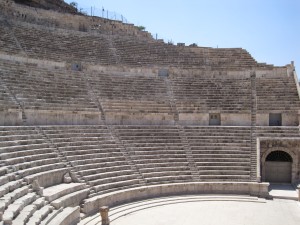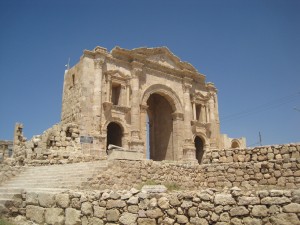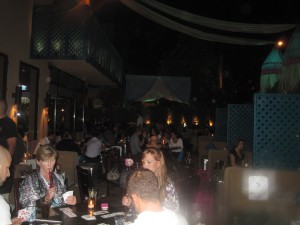Amman, Jerash and the Dead Sea
Posted: 20/09/2011 Filed under: Jordan | Tags: Amman, Dead Sea, Jerash, Jordan Leave a commentI spent 2 weeks in Jordan in August 2010 with my friend Sarah, and it was possibly the best trip I’ve ever taken. Jordan is a fabulous country, and a great place to visit for a couple of weeks – just small enough to get around easily, but with so much to see and do that you find it difficult to pack it all in. We flew from Birmingham with Lufthansa, changing at Frankfurt. Sarah was working in Germany at the time and had a Lufthansa gold card, so we enjoyed use of the lounges, a first for me! Gin and tonics, free snacks (including some very tasty noodles at Frankfurt) and comfort. Possibly my most enjoyable flight ever. It helped that the flight from Frankfurt to Amman was almost empty, so we got to lie down and have a nap on the way. We arrived at 1am, and luckily found a taxi almost straight away. The driver chatted to us all the way back to our hotel, firing questions at us, and had us giggling as he tried (unsuccessfully) to impress us enough to want to spend our entire time being driven around by him. Almost every taxi driver you meet in Jordan is like this, not content with taking you from A to B, they all know that the real money is in you hiring them as a driver for two weeks. We took his card, and promised to keep him in mind.
The hotel (booked by me almost at random) came as a complete surprise. We weren’t expecting much, but it turned out to be a stunning little hotel in one of the back streets of the city, clearly catering to a business clientele. There was tight security on the way in, and bags and people had to go through a scanner. This is because Jordan has had it’s own problems, in 2005 three hotels known to be frequented by westerners were targeted by suicide bombers, killing 60. However, there was no sense of danger as we checked in and were shown to a bright, spacious room, clean and on a par with business class hotels in the UK. We woke to a delicious breakfast, fruit, yoghurt and coffee, with omelettes and scrambled eggs made to order. We decided to use our first day in Amman to look around the city itself. We took a taxi downtown and marvelled at the sheer size of the city. 2.8 million live in the Amman area, over a third of the population. It is extremely built up, browny cream 4 or 5 storey buildings stretch to the skyline with barely a tree in between. Amman as a city is growing quickly, immigrants pile in from neighbouring Palestine, Iraq and Egypt. Jordan is a largely peaceful country in the midst of the tinder box that is the Middle East, so it’s not surprising that the number of immigrants is so high.
We started our Jordanian adventure in the Citadel, the remains of Roman Amman. The taxi driver dropped us off at the entrance on Citadel Hill, and we were collared by a guide on the way in. Thinking that it might actually be quite good to have someone to tell us some history, we agreed a price for him to show us around. The guide was good value, he told us all about the history of the site. It dates back to around 180 AD, and the Temple of Hercules is said to have been commissioned by Marcus Aurelius. However, pottery from the Neolithic period has also been found here making it one of the world’s oldest continuous occupied sites. The area now looks like a huge Roman junkyard, with parts of columns and statues scattered across the hill, including a giant hand. The guide took us into one tomb to demonstrate how the light was designed to come in at a certain angle to highlight the alter. He left us at the entrance to the small museum, explaining that he was not allowed to come in with us and advising us on what we should see. The museum is tiny, not much more than a single room, but has some fascinating artefacts on display.
Then came the trouble. As we left the museum, intending to go to the Roman Amphitheatre, the guide muscled in and insisted on showing us the way. Taking us down some very precarious steps and along a path that seemed very insecure, he then marshalled our way along some very busy city streets. We weren’t at all sure how to get rid of him, or how much this extra “added service” was going to cost us. When we arrived at the amphitheatre, we firmly said goodbye and asked how much we owed, but he insisted on taking us first to meet his sister, who turned out to be running a shop just above the amphitheatre entrance. Hmmmm, very convenient! We paid him some money for guiding us to the amphitheatre, had a polite and cursory look around the tacky souvenir shop and headed back down to the theatre, wiser in the ways of the guide. We would manage to avoid them for the rest of the holiday. The Roman theatre is definitely worth a visit, it is the largest in Jordan, and could have seated 6,000 in it’s heyday. In 2006, this was the scene of a tragedy, when 5 western tourists were shot by a gunman, one killed. It seemed very remote from us on this day, a bright August afternoon, with sunny blue skies. We were almost the only people there. We did have our own strange experience there though. Sitting on the very top seats of the theatre, drinking in the view (you can see the citadel, perched on top of the hill from there), we noticed a young man in a white baseball cap. When we moved, he moved. He kept coming closer to us, sitting down eventually a few feet away. He seemed keen to get our attention, for what, we weren’t sure, but it did not make the visit a pleasant experience, and we quickly left to explore the streets of the city. Amman is not geared for tourists, and the streets themselves are dusty and ordinary and downtown seems poor, at odds with the shiny new buildings you find in other Middle Eastern states. There are some, but they are few and far between. Both of us remarked on the very few women that seemed to be out and about on the streets, we barely saw any, and those we did see were accompanied by a man.
The one problem with our hotel appeared to be the location. Our bungled pronounciation of the name didn’t help, but even presenting taxi drivers with the card and a map did not seem to help. We hailed a taxi on the street and the driver had such difficulty understanding that he ended up stopping random people in the street and finding out if they spoke English and could translate. Eventually, he ran off into a shop and came out looking harassed but more confident about where he was going. He seemed to look upon us as a bit of a nuisance, and certainly didn’t offer us his card or to drive us around for the rest of our trip! We ate that night at the hotel, and booked ourselves a driver for the next day to Jerash, approximately an hour away. The driver turned out to be a very handsome man with incredibly long eyelashes, who was also quiet and not intrusive so we both quite enjoyed the journey, chatting about this and that. We arrived at Jerash in the heat of the midday sun. Jerash was a Roman city, also known as Antioch on the Golden River. It was already inhabited in the Bronze age, but much of what you can now see was built from around 100AD to 400AD. It is one of the best preserved Roman cities in the Near East, certainly the best preserved I have seen, with the possible exception of Ephesus in Turkey. On approach you come to Hadrian’s Gate, which was built to celebrate the visit of the Emperor Hadrian in 129 AD. It’s an imposing way to enter a city, even today the columns and archways are impressive. From there you enter what would have been a teeming city, with a population of around 20,000 at it’s height before the invading Persian armies and a large earthquake in the 9th century started the decline of the city. The remains of several important buildings, including a nymphaeum and several small temples, and a large hippodrome and theatre lie just beyond the gate. As you wander up the road, you come to an oval and quite beautiful forum, which amongst other things marked the centre of trade for Jerash. The streets are paved with the original stones, and you can still see the ruts made by chariots, a remarkable and touching historical detail. Chariot races are still put on in the hippodrome as a modern day tourist attraction, but apart from a few horses tethered around the entrance we saw nothing of this – perhaps we were out of season. We took the opportunity to climb to the top of the temple of Artemis, from where we got an amazing view of modern day Jerash, a city which has grown rapidly in recent years. Unfortunately we did not get time to look around it, as our driver was booked to take us back later that afternoon. There were some spectacular views on the way back to Amman, we asked our driver to stop so that we could take photos of the landscape, gorgeous hills gently undulating to the meandering river – Jordan is a beautiful country.
We ate that night at an intriguing Chinese restaurant that we could see from our hotel room window. We were the only diners, guessing that Chinese food isn’t that popular for an Iftar meal. Still it was tasty enough. I find that Chinese food varies incredibly from country to country, and I have to say I liked the Middle Eastern take on it much more than the
British. Our handsome driver was booked again for the next day to take us to the Dead Sea for the day. Again, this is an hour or so’s drive from Amman. Enormous luxury hotels are dotted around the Dead Sea coast, all promising spa treatments and access to the salty water, but we eschewed these and instead went to the public beach, where for much less money you can find changing facilities, a café and shop, pools, nice shady areas, and have access to a long stretch of sandy beach. It is (obviously) very popular though, so I’d advise getting there as early as you can if you want a sunbed, particularly one in the shade. We were both keen to get in the sea and find out what it was like to float unaided in the saltiest sea on the planet. The Dead Sea is also the lowest point on earth, and one of the hottest places I’ve ever been. When the driver parked up, he laughed and pointed at the temperature gauge on the car: 45 degrees C. That’s hot! And it would only get hotter as the day went on. We could see the hills of Israel on the other side of the sea, within swimming distance: an intriguing thought. The sea itself is calm, with a layer of sharp, pointy salt deposits around the edge, which means you have to tread carefully as you ease your way in. It is definitely designed for the lazy, as everything you’ve heard is true – no swimming required to keep yourself afloat. The oddest thing is trying to turn over from your front to your back, this is a lot more difficult than in a normal sea, quite a disorientating experience. The other strange thing is bathing in a sea with absolutely NO life in it. Not even a patch of weeds can survive the high concentrations of sodium chloride, no watching out for sea creatures or cutting your foot on a shell or getting seaweed in your hair… For a small fee though, you can cover yourself in Dead Sea mud (supposed to be great for the skin), let it dry in the sun and then wash it off in the salt. I had a go (Sarah sensibly stuck to swimming and reading on the beach) but got too overexcited and washed it off too soon.
We had a look around the shop and bought some creams for our friend, who has psoriasis. Dead Sea minerals are supposed to be excellent for skin problems. We had a drink in the café, but neither of us fancied eating there. It was a buffet and we weren’t sure how long the food had been out. Soon we were happily ensconced back in the car, admiring our driver’s eyelashes, and being taken back to our hotel in Amman, salty but relaxed. We decided to eat that night at the Blue Fig Café, a Lonely Planet recommendation. They weren’t wrong, the Café was absolutely wonderful, offering a superb four course Iftar meal. The wonderfully relaxed atmosphere there is to be savoured, the locals sit around drinking tea, smoking water pipes and playing cards and backgammon, chatting loudly. The décor is all Arabic cushions, lanterns and colourful throws. A brilliant evening to bring our time in Amman to a close. Next day was an early start, as we headed off to Petra.





